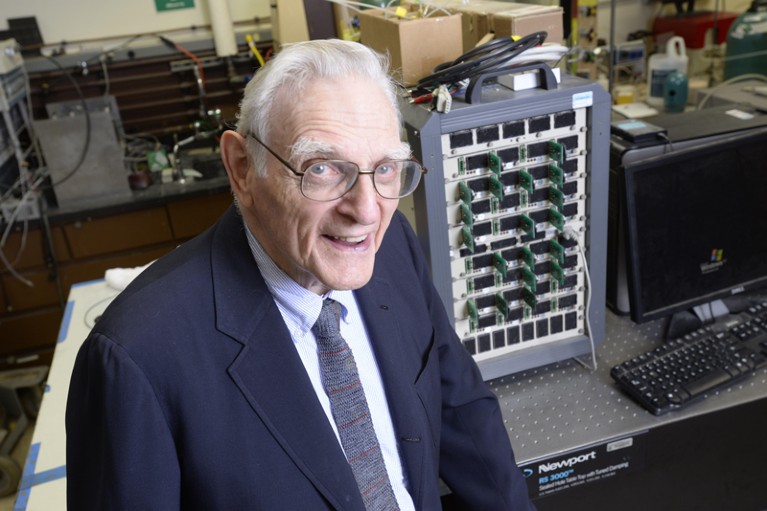
Credit: University of Texas at Austin via Sipa US/Alamy
John Goodenough is best known for his 1980 invention of the rechargeable lithium battery, which is used in myriad devices, from electric cars to mobile phones, and holds the key to decarbonizing the world’s energy system. Lithium batteries are just one of the technologies that he pioneered, through his insights into metallic oxides and magnetic interactions in solids.
In the 1950s and 1960s, Goodenough was a leader in the development of the first solid-state random access memory (RAM) devices for computers. In the 1970s, he predicted the existence of high-temperature superconductivity, the flow of electricity without resistance in conditions above 77 kelvin. At the age of 97, John shared the 2019 Nobel Prize in Chemistry with Stanley Whittingham and Akira Yoshino for their work on lithium batteries. He has died aged 100.
Goodenough grew up in New Haven, Connecticut, near Yale University. Despite early struggles with dyslexia, he entered Yale in 1940 to read philosophy, Greek, mathematics and chemistry. This intellectual breadth influenced the importance that he later attached to interdisciplinary research. After serving as a meteorologist for the US Army during the Second World War, at 24 years old he enrolled to study for a physics PhD at the University of Chicago in Illinois. In his 2008 autobiography Witness to Grace, John recalls the professor who registered him saying: “I don’t understand you veterans. Don’t you know that anyone who has ever done anything significant in physics had already done it by the time he was your age?” He clearly was an exception.
How to make lithium extraction cleaner, faster and cheaper — in six steps
Under the tutelage of Clarence Zener, Goodenough excelled in solid-state physics. Chicago was also where he met his wife, Irene. Their shared Christian faith defined their life choices together. After briefly considering ordination, John moved to the Massachusetts Institute of Technology (MIT) in Cambridge to work on materials for computer memories. There, he changed what had been a systematic, empirical approach to the chemistry behind magnetic interactions into a rational, rule-based understanding, which was later codified as the Goodenough–Kanamori rules. His first book, Magnetism and the Chemical Bond (1963), defined the state of the art. His 1972 review of metallic oxides (J. B. Goodenough Prog. Solid State Chem. 5, 145−399; 1971) is an encyclopedic account of the behaviour of electrons in the transition-metal oxides that underpin a host of technologies, from digital computers and microelectronics to photovoltaics, lasers, solid-state lighting, superconducting devices and batteries.
In the 1970s, Goodenough turned his attention to renewable energy amid his concerns about the volatility of the international oil trade. His focus was on developing technologies that could be used in lower-income countries. In 1976, he was appointed head of the Inorganic Chemistry Laboratory at the University of Oxford, UK. There, his focus turned to lithium batteries, building on earlier work on sulfide-based materials by Whittingham at oil company Exxon. Realizing that oxides were the better option, Goodenough’s small group launched a tour de force in electrochemical techniques for battery fabrication, and achieved the first demonstration of an effective rechargeable lithium battery based on lithium cobalt oxide. Shortly afterwards, he was instrumental in recognizing the utility of lithium manganese spinel as a cathode material.
Could grinding up lithium batteries help to recycle them?
Oxford required John to retire at 65, so, a year early, in 1986, he made his final academic move, to the University of Texas at Austin. He witnessed the discovery of high-temperature superconductivity, which he had predicted in the early 1970s, and provided chemical insights into the unusual behaviour of materials that displayed it. His main focus, however, remained battery research, and in 1997 he discovered another key family of cathode materials, based on lithium metal phosphates.
John was defined by his principles and was a true humanitarian with a deep sense of justice. In 1985, he was invited to visit South Africa, then under apartheid. Recognizing the country’s importance for the future development of Africa, he ignored pressure from Oxford to decline the invitation, saying to one of us (M.T.), “How is it possible to judge, and help, a country without observing and experiencing life there at first hand?” John discussed scientific and technological opportunities with South Africa’s academic and industrial communities and visited the black township of Soweto.
Apart from stepping aside from full-time research for three years in his early nineties to care for Irene, John continued to go to work most days. Three years before his Nobel prize, an interviewer on BBC radio put to him the widely held view that he should have received the award years earlier. “Prizes are decisions made by those who do the awarding,” he replied. “But that’s what I call ‘wood, hay and stubble’. The main thing is, ‘What is your contribution really to society?’” In 2019, he became the oldest Nobel laureate.
Large in stature, with a formidable intellect, John was genial and kind yet patrician and private, quietly considered but with a long, loud and exuberant laugh. As his frank autobiography describes, his life was shaped by the delights and trials of his rural childhood and defined by his and his wife’s shared faith.

 How to make lithium extraction cleaner, faster and cheaper — in six steps
How to make lithium extraction cleaner, faster and cheaper — in six steps
 Could grinding up lithium batteries help to recycle them?
Could grinding up lithium batteries help to recycle them?
 Make electric vehicles lighter to maximize climate and safety benefits
Make electric vehicles lighter to maximize climate and safety benefits
 Electric cars and batteries: how will the world produce enough?
Electric cars and batteries: how will the world produce enough?
 Cool metric for lithium-ion batteries could spur progress
Cool metric for lithium-ion batteries could spur progress







